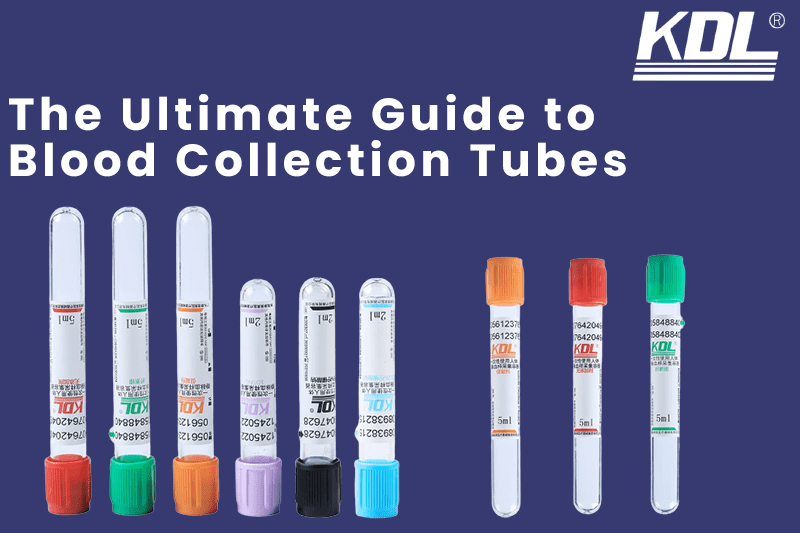
What is Blood Collection Tubes
Blood collection tubes, also know as vacutainer tubes or phlebotomy tubes, are sterile tubes use to collect and transport blood specimens for medical testing or analysis. They are design to draw and store a specific volume of blood, usually ranging from 2-10 milliliters, depending on the type of tube used and the intended application.
KDL Blood collection tubes are made of plastic or glass and contain various additives, such as anticoagulants or preservatives, to maintain the quality of the blood sample for testing. They come in different sizes, colors, and types, each with a unique combination of additives to suit specific testing requirements.
Importance of Blood Collection Tubes
Blood collection tubes play a crucial role in the collection and analysis of blood samples for medical purposes. There are essential tools use by healthcare professionals, such as phlebotomists, to collect blood specimens from patients for diagnostic tests, blood donations, and research studies.
Blood collection tubes help to ensure the accuracy and reliability of blood test results by providing a standardized and controlled environment for the blood sample. Each type of tube is design with specific additives, such as anticoagulants or preservatives, to preserve the integrity of the sample and prevent clotting or degradation.
The correct use of blood collection tubes is critical for accurate and reliable diagnostic test results. Different types of tubes are use for different types of tests, and following the appropriate protocol for collecting blood samples is essential to avoid errors or contamination.
Different types of Blood Collection Tubes
There are several types of blood collection tubes, each designed for specific types of blood tests. Some of the most common types of blood collection tube discuss below.
Serum Separator Tube (SST):
This tube contains a gel separator that helps separate the serum from the blood cells after centrifugation. It is use for a wide range of tests, including blood chemistry, hormone assays, and serology.
Ethylenediaminetetraacetic acid (EDTA) Tube: This tube contains EDTA, which binds to calcium and prevents blood from clotting. It is use for hematology tests, such as complete blood count (CBC), blood typing, and DNA analysis.
Heparin Tube
This tube contains heparin, which also prevents blood from clotting. It is use for tests that require plasma, such as coagulation studies, thrombin time, and fibrinogen assays.
Sodium Citrate Tube
This tube contains sodium citrate, which also acts as an anticoagulant. It is use for coagulation studies, including prothrombin time (PT), activated partial thromboplastin time (aPTT), and D-dimer.
Fluoride Tube
This tube contains a mixture of fluoride and an anticoagulant (usually EDTA). It is use for glucose testing, as the fluoride prevents glycolysis (the breakdown of glucose in the blood sample).
Blood Culture Bottle
This tube is use for collecting blood specimens for microbiological culture, which helps identify bacterial or fungal infections in the blood.
The choice of blood collection tube depend on the type of test to be performe and the specific requirements of the laboratory. It is essential to follow proper blood collection techniques to ensure accurate and reliable test results.
Best Practices for Blood Collection Tubes
Blood collection tubes are an essential tool for drawing blood samples for various medical purposes, including diagnostic tests, blood donations, and research studies. Here are some best practices for using blood collection tubes:
Handling and Storage
Blood collection tube should be stored at the appropriate temperature, as specified by the manufacturer, to maintain the integrity of the sample. Tubes should be handled with care to prevent damage or contamination.
Order of Draw
The order of draw should be followed to minimize the risk of cross-contamination between tubes. The order of draw is the sequence in which tubes are filled during a blood draw. This helps prevent the transfer of additives or contaminants between tubes.
Needle Size and Angle
The needle size and angle used for blood collection needle should be appropriate for the patient’s age and size. A needle that is too large or inserted at the wrong angle can cause pain and bruising.
Avoiding Hemolysis
Hemolysis, the breakdown of red blood cells, can occur if the blood collection process is not done correctly. This can result in inaccurate test results. To avoid hemolysis, the phlebotomist should use the appropriate size needle, avoid excessive suction, and invert the tube gently after collection.
Uses of Blood Collection Tubes
Blood collection tubes are use for a variety of medical purposes, including:
Diagnostic Testing
Blood collection tube are use to collect blood samples for diagnostic testing to evaluate a patient’s health status or detect the presence of diseases or infections. The tests can include complete blood count (CBC), blood chemistry panel, blood glucose, blood lipid profile, and various other tests.
Blood Donation
Blood collection tubes are use to collect blood from blood donors for transfusion to patients who need blood. The collected blood is tested for various bloodborne diseases, such as HIV, hepatitis B and C, and syphilis, to ensure the safety of the donate blood.
Research Studies
Blood collection tube are use to collect blood samples for research studies to investigate various diseases and conditions. The collected blood samples can be use for genetic studies, biomarker analysis, and other types of research.
Drug Monitoring
Blood collection tube are use to collect blood samples for drug monitoring to measure the concentration of drugs or medications in a patient’s bloodstream. The results of drug monitoring can help to ensure that patients receive the appropriate dosage of medication for their condition.
What is Vacuum Blood Collection Tube
Vacuum blood collection tube, also known as Vacutainer tubes, are plastic or glass tubes used for the collection and transportation of blood samples for clinical testing. These tubes have a cap with a rubber stopper that create a vacuum when the needle pierces the stopper, allowing blood to be draw into the tube without the need for a syringe.
The vacuum in the tube contributes to the fact that a certain amount of blood is collecte and the blood is evenly distribute in the tube. The tubes come in different sizes and colors, each designed for specific types of blood tests.
Vacutainer tubes have revolutionized blood collection, making it easier, faster, and less painful for patients. They are widely use in hospitals, clinics, and laboratories around the world.
Conclusion
Blood collection tubes are important instruments use in the medical field to collect and transport blood samples for various purposes. They have special additives to preserve the integrity of the blood sample and prevent clumping or deterioration of test results. Healthcare professionals must follow the appropriate protocol for collecting blood samples to achieve the best outcomes. KDL is a leading blood collection tubes Manufacturer & Supplier company that produces different types of blood Collection tube. We are one of the leading pen needle or syringe manufacturers suppliers in the industry.

